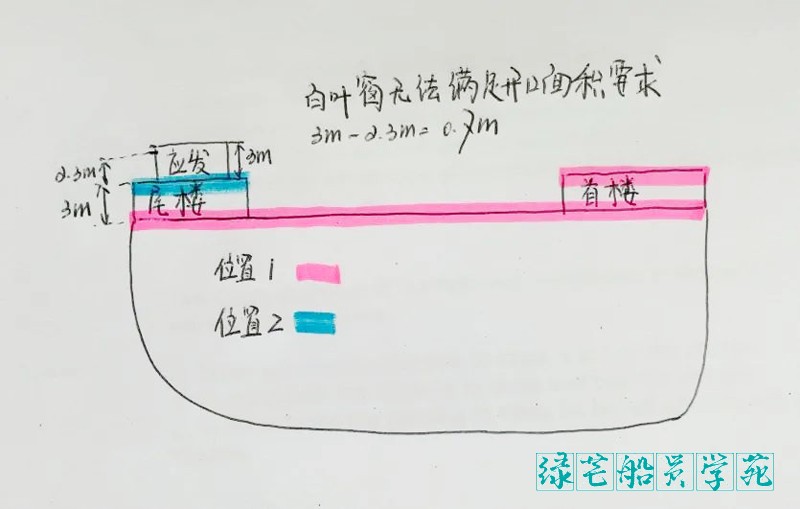船舶虚拟干舷是什么?
01船舶的虚拟干舷是什么?
除却《载重线公约》第 2 条 适用范围 (6)有如下要求,再没有找到任何相关描述。

解读前
如果核定的夏季干舷增至使最终吃水不超过同一船舶相应于最小夏季干舷的吃水,且假想干舷甲板的位置在该船实际干舷甲板的至少一个标准上层建筑高度以下,则按照第 12 条、第 14-1 至第 20 条、第 23 条、第 24 条和第 25 条对实际干舷甲板适用的核定条件可与对上层建筑甲板的要求相同。
大白话解读后
如果核定的夏季干舷增至使最终吃水不超过同一船舶相应于最小夏季干舷的吃水(编者注:设计干舷 > 最小干舷,设计船舶主尺度时型深减去吃水的值都会留有余量),且假想干舷甲板(编者注:英文为assumed,即为虚拟)的位置在该船实际干舷甲板的至少一个标准上层建筑高度以下(编者注:即虚拟干舷甲板比实际干舷甲板按照一定高度要求降低,保证储备浮力),则按照第 12 条、第 14-1 至第 20 条、第 23 条、第 24 条和第 25 条对实际干舷甲板适用的核定条件可与对上层建筑甲板的要求相同(编者注:满足上述条件,虚拟的就是实际的了)
02解决
IACS (International Association of Classification Societies 国际船级社协会) LL.51 (Unified Interpretations of the Provisions of the International Convention on Load Lines载重线公约的统一解释) 给出如下注解:
解读前
Where freeboards are not required to be increased, because of such considerations as strength (regulation 1), location of shell doors(regulation 21) or sidescuttles (regulation 23) or other reasons, then:
1 the height of
door sills (regulation 12)
hatchway coamings (regulation 14-1)
sills of machinery space openings (regulation 17)
miscellaneous openings (regulation 18)
ventilators (regulation 19)
air pipes (regulation 20)
2 the scantlings of hatch covers (regulations 15 and 16)
3 freeing arrangements (regulation 24) and means for protection of crew (regulation 25)
on the actual freeboard deck may be a required for a superstructure deck, provided the summer freeboard is such that the resulting draught will not be greater than that corresponding to the minimum freeboard calculated from an assumed freeboard deck situated at a distance equal to a standard super-structure height below the actual freeboard deck. Similar considerations may be given in cases of draught limitation on account of bow height (regulation 39).
当因为强度(regulation 1)、舷门位置(regulation 21) 、舷窗位置(regulation 21) 或其他原因,而干舷又没有被要求增加时,那么:
1 下述项目的高度
门槛 (regulation 12)
舱口围板 (regulation 14-1)
机器处所开口门槛(regulation 17)
各种开口 (regulation 18)
通风(regulation 19)
空气管 (regulation 20)
2 舱口盖尺寸 (regulations 15 and 16)
3 排水舷口布置 (regulation 24) 和对船员保护的方法 (regulation 25)
如果设计干舷大于最小干舷,且虚拟干舷甲板的位置在该船实际干舷甲板的至少一个标准上层建筑高度以下,则虚拟干舷与实际干舷同等。如果因为吃水限制,在计算最小船首高时,也可以采用虚拟干舷的概念(regulation 39)。
虚拟干舷甲板顾名思义——不是真实存在的干舷甲板。它的位置一般取决于该船的一个标准上层建筑高度,目的是为了降低对于通风、空气管布置高度或者舱盖的密性等要求。
第33条 上层建筑标准高度 | ||
船长(m) | 后升高甲板(m) | 所有其他上层建筑(m) |
30或30以下 | 0.9 | 1.8 |
75 | 1.2 | 1.8 |
125或以上 | 1.8 | 2.3 |
船长为中间值时,其标准高度应按线性内插法求得。 |
|
|
介绍了那么多术语,我们来举一个实例——应急发电机室的百叶窗高度不能满足距离位置2,2.3m的要求(详见位置1和位置2有什么用)。假定该船船长超过125m,它的标准上层建筑高度为2.3m,每层上建实际高度为3m。
03终极
保险起见,是否能采用虚拟干舷,降低相关标准,还是提前与船级社沟通确认为好。虚拟干舷的确是提供了一条变通设计的思路和方法,当然,前提是保证该船的完整和破舱稳性。
- 发表于 2023-10-25 07:52
- 阅读 ( 622 )
你可能感兴趣的文章
相关问题
0 条评论
文件生成中...
请稍候,系统正在生成您请求的文件

船舶虚拟干舷是什么?

扫码过程中请勿刷新、关闭本页面,否则会导致支付失败
购买后请立即保管好,30天后需重新付费。

船舶虚拟干舷是什么?

扫码过程中请勿刷新、关闭本页面,否则会导致支付失败
购买后请立即保管好,30天后需重新付费。
请点击下载或复制按钮进行操作
